Human Impact & Sustainable Solutions - Grades 4 -8
Recommended for 4th - 8th grade students. Herbicides, pesticides, oil, gas, and soil erosion all impact the health of the watershed in which we live. Where does it all come from, and what alternatives, or best management practices, are available to ensure a lighter more sustainable interaction with our watershed ecosystems? During this presentation students make hypotheses, and conduct experiments to determine the effects of our everyday practices on land and water resources and learn about best management practices designed to mitigate the effect on water quality.
Fee:
* $160.00 per class of up to 24 plus a $10 travel and transportation fee per class when held at your classroom
* $8.00 per student ($80 minimum per class) when held at the Conservancy
For more information or for reservations contact: PWC Education Department at education@perkiomenwatershed.org
PA STEELS Standards addressed in lesson include:
3.1.5.A Support an argument that plants get the materials they need for growth chiefly from air and water.
3.1.6-8.K Develop a model to describe the cycling of matter and flow of energy among living and nonliving parts of an ecosystem.
3.3.5.E Obtain and combine information about ways individual communities use science ideas to protect the Earth’s resources and environment.
3.3.5.F Generate and design possible solutions to a current environmental issue, threat, or concern.
3.3.6-8.M Apply scientific principles to design a method for monitoring and minimizing human impact on the environment.
3.3.6-8.N Construct an argument supported by evidence for how increases in human population and per capita consumption of natural resources impact Earth's systems.
3.4.3-5.A Analyze how living organisms, including humans, affect the environment in which they live, and how their environment affects them.
3.4.3-5.B Make a claim about the environmental and social impacts of design solutions and civic actions, including their own actions. 3.4.6-8.B Analyze and interpret data about how different societies (economic and social systems) and cultures use and manage natural resources differently.
3.4.6-8.C Develop a model to describe how watersheds and wetlands function as systems, including the roles and functions they serve.
3.4.3-5.D Develop a model to demonstrate how local environmental issues are connected to larger local environment and human systems.
3.4.6-8.D Gather, read, and synthesize information from multiple sources to investigate how Pennsylvania environmental issues affect Pennsylvania’s human and natural systems.
3.4.6-8.E Collect, analyze, and interpret environmental data to describe a local environment.
3.4.3-5.E Construct an argument to support whether action is needed on a selected environmental issue and propose possible solutions.
3.4.6-8.F Obtain and communicate information on how integrated pest management could improve indoor and outdoor environments.
3.4.6-8.G Obtain and communicate information to describe how best resource management practices and environmental laws are designed to achieve environmental sustainability.
3.4.3-5.F Critique ways that people depend on and change the environment.
3.4.6-8.H Design a solution to an environmental issue in which individuals and societies can engage as stewards of the environment.
PDE Academic Standards addressed include:
3.3.5.A4 - Explain the basic components of the water cycle.
4.2.5.C - Identify physical, chemical, and biological factors that affect water quality.
4.5.5.C - Explain the difference between point and non-point source pollution.
3.3.6.A4 - Describe how water on earth cycles in different forms and in different locations, including underground and in the atmosphere.
4.2.6.C - Identify natural and human-made factors that affect water quality.
4.2.7.A - Explain how water enters, moves through, and leaves a watershed.
4.5.7.C - Explain how human actions affect the health of the environment.
4.2.8.A - Describe factors that affect the quality of ground and surface waters.
4.5.8.A - Explain how Best Management Practices (BMP) can be used to mitigate environmental problems.
4.5.8.C - Describe how humans can reduce pollution.






